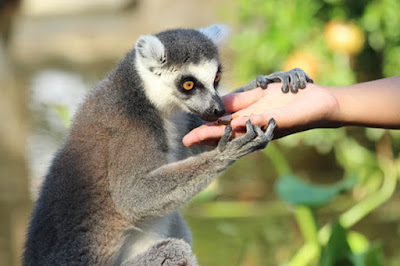This
animal collection originally opened in 2006 under the name “Kachoen” (Japanese for “Bird – Flower Park
Contact Animals Zone
Upon
first entering the indoor facility, one sees a room where visitors can play
with dogs and cats. I skipped this area
and moved onto the area with the rabbits and guinea pigs. These animals are displayed in a manner that
allows visitors easy access to touch and pet them. Some might say that there is too much access
to the animals.
Watch where you step: rabbits are everywhere. And although signs tell visitors to leave the animals alone if they move into certain marked off areas, there really was nowhere for the animals to escape from overeager, excited young children.
The guinea pigs were kept in elevated pens at a height at which adults and older children could easily reach them.
There was a sign explaining the guinea pig’s scientific name, characteristics, eating habits, and original habitat range. Similar signs were posted for all of the various animals in the park.
This panel board featured photos of each of the guinea pigs in this area, complete with their names.
These signs set out rules for visitor behavior.
Fish Handling and Water
Lilies Zone
This area featured two pools
of water. The smaller pool contained small
fish, and for 300 yen, visitors could rest their feet in the pool and have the
fish eat the dead skin off their legs.
This experience supposedly leaves the visitor with smooth skin, but
since the idea of fish sucking on my toes with their bacteria laden lips gives
me the creeps, I passed on this activity. Visitors could also buy fish food for 100 yen.
The larger pool was full of giant water lilies. This area was used for bird shows featuring trained Macaws and small owls.
Flower Shower Area
The next area featured many
giant hanging planters with various colorful flowers.There was also a small corner with four owls that were identified as: a Verraux’s Eagle Owl, a Rock Eagle Owl, a Barn Owl, and a White-Faced Scops Owl. These owls were secured by rope tethers to two large logs, and visitors were allowed to get within one meter of the animals.
White-faced Scops Owl
Pelican Lagoon Zone
Located in the middle of the
greenhouses, the Pelican Lagoon is a large shallow pool only centimeters
deep. In the middle of the pool, there
was an artificial island which provided a habitat for many of the animals. Below are photos of some of the birds and
other animals kept in this area.White pelican
Grey-crowned Crane
Scarlet Ibis
Ruddy Shelduck
Female Mandarin duck
Black-necked Stilt
Sitatunga
A zookeeper did a “show-and-tell” program about the Ring-tailed Lemurs.
Tropical Forest Zone
This zone housed what was
labeled as African spurred tortoises, Aldabra giant tortoises, a Burmese black
forest tortoise, and a Red-footed tortoise.
Although visitors were free to touch the animals, it appeared the
animals preferred to move away from the visitors, especially the young children
who seemed to regard them as toys.Food for the tortoises was 100 yen.
Two-toed sloth display
Keeper feeding sloth
Birds overhead
Toco toucans
One cup of bird feed for 100 yen.
Aqua Valley Zone
This area featured American
Beavers, South American Fur Seals, Capybaras, and Patagonian Cavys (Mara). Visitors were allowed, and even encouraged,
to feed and touch the Capybaras and American Beaver tank
South American Fur Seal
Capybara area
Buy a ticket to feed the Capybaras - 100 yen, or six tickets for 500 yen.
Mara
Outside Area
Stepping
outside of the greenhouse complex, visitors can interact with a number of
animals housed outdoors.
“Kangaroo Farm”
Visitor contact with the Red Kangaroos was supervised by a zookeeper
“Alpaca Space”
“Sheeps Hill”
Pygmy goat in sheeps’ area
Bactrian Camel in “Camel Corner”
“Horse Ride” area
African Wetland
This area housed a pair of Shoe-Billed
Storks, Maribou Storks, and Red River Hogs.People were allowed to get very close to the Shoe-billed Stork. Amazingly, the stork didn’t show much of a response.
Animal Promenade
This
area served as a second entrance to the facility for visitors who came by car. (There is a large parking lot on this side of
the facility.)
There was also a Bald Eagle. The enclosure for this eagle was about 4 meters long and about 2 to 3 meters from window to the wall.
Food and Souvenirs
There were three places to buy
food in the facility: a burger counter, an all-you-can-eat buffet restaurant,
and a café counter. I decided to try the
buffet which was priced at 1430 yen for adults.This is what I picked up from the buffet: curry and rice, French fries, fried chicken karaage, meatballs, and some vegetables. Lots of fried foods – not very healthy.
There was a very well stocked souvenir store with lots of snacks and branded goods.
There were also lots of stuffed toys…
…and even a plant shop.
Getting There
Visitors
should first make their way to the Sannomiya area where the Hankyu Railways,
the JR Railways, and Hanshin Railways each have a station. At Sannomiya, visitors should look for the
Port Liner monorail which is located in the building adjacent to the JR
Sannomiya Station. At the Port Liner
station, visitors board the monorail heading for Kobe Airport Kobe Airport Port Island
The view as you descend the stairs from the monorail station.
Admission
was 1500 yen for adults, 800 yen for children under 12 years old, 300 yen for
children 4 to 5 years old, and 1100 yen for seniors over 65 years old.
(Note:
All photos taken in this post were taken during a visit on August 15, 2015. The comments in this post are based on
observations made on that day.
Conditions may have since changed.
Please check it out for yourself!)









































































